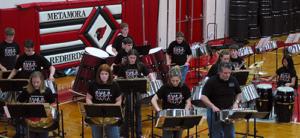09 Feb Boost your Music Education Program With One Simple Addition: Steel Drums

It doesn’t have to be all or nothing when it comes to steel drums. If you’re interested in trying out a steel pan and adding it to your ensemble, do it! The sound of the steel pan adds a joyous, celebratory element to any already-existing band or ensemble, whether it’s large or small.
While the steel drum traditionally has a sound that evokes the sense of the islands, it can also add a melodic, rhythmic sound to other genres of music. They can be featured in solos, or add chime-like accents to any song your band plays.
If you don’t want to invest in a full-size pan, you can add an affordable, smaller Jumbie Jam!
What is a steel pan, or steel drum?
Steelpan, also known as a steel pan or steel drum, is a traditional percussion instrument that was invented in Trinidad and Tobago. Many Caribbean countries have adopted the steel drum as part of their traditional music.
The drums can be part of an entire steel pan ensemble, or played individually to great effect. The first “pan” used in Trinidad was an empty biscuit container. Next, the people of Trinidad discovered that you could hammer out a tin, resulting in different notes that could be played. Winston “Spree” Simon, in 1930s at the age of 14, is considered the inventor of the tuned tins.
Tamboo Bamboo and Skin Drums were banned in the 1880s by the then-British Empire, which had colonized the islands. At that point, they became an underground celebratory instrument. By the 1930s the tuned tins became a significant part of the country’s Carnival festivals. The builders using biscuit tins then evolved into utilizing oil drums to make pans partly due to the war — oil barrels were in high supply.
The steel pan, in the early days, was associated with gangs as rival bands clashed, which many times resulted in violence. But by the late 1950s, it was a mainstay of the culture and the love of the steel drum spread to other countries, including the UK. They played an important role during Trinidad’s independence celebrations in 1962.
The role of steel drums in music education
As you can see, there is a lot of history that can be taught to students as they learn to play the steel pan. It’s a multicultural instrument that can be brought into any size classroom or band room.
Beth Ann Hepburn, a music educator & and well known Orff clinician of 25 years, has used Jumbie Jams in her classroom for 10 years.
“As a teacher, it allows you a lot of flexibility to be a solo instrument or part of the ensemble,” she said. “You can feature a student on that instrument if you want, or you can make it part of what you’re doing with the whole class. Having both solo and ensemble capabilities is really great.”
Hepburn uses the ORFF method, which involves dance, music, and multiple percussion instruments. Adding Jumbie Jams just adds to the melodic nature of her students’ experiments.
Steel drums offer a simple way to learn how to read music, but reading music isn’t a prerequisite to playing them. They also come in multiple tonalities.
Schools across the nation have incorporated both Jumbie Jams and full-size pans into music education. At Franklin Preparatory Academy in central Ohio, for example, the steel drum class is very popular among both students and parents. While they play and perform traditional Calypso music, they also play classic rock, modern hits and Christmas music.
Panyard’s instrument offer both affordability and quality
Eric B. Schrader, director of bands at Greenville High School in Pennsylvania, taught a steel pan band with both Panyard instruments and non-Panyard instruments.
“Before I started using Panyard instruments, my groups’ timbre was mediocre at best,” he told us. “Prior to utilizing Panyard Pans, I applied several times to the Pennsylvania Music Educators Association Conference to no avail.”
But the first year he and his students began using Panyard drums, his group was accepted into the prestigious festival.
“A school my size (120 graduate a year) can afford any instrument under $2,000 on a yearly basis. Most quality brands of instruments, like tenor saxes, bass clarinets, and intermediate horn types cost at least $1,500 or more,” he said. “With the price of a steel drum under $2,000, all schools can afford pans and promote this wonderful art form. The high craftsmanship coupled with a reasonable price for pans is a win-win situation for all involved.”
If you’re ready to add a steel pan — or a few! — to your ensemble or band, shop our products here. We’re available to answer any questions you may have, so if you aren’t sure what the best instrument is for you, just email us at [email protected]. s

Sorry, the comment form is closed at this time.